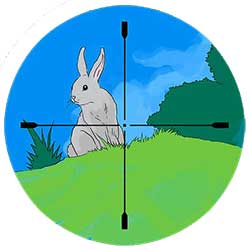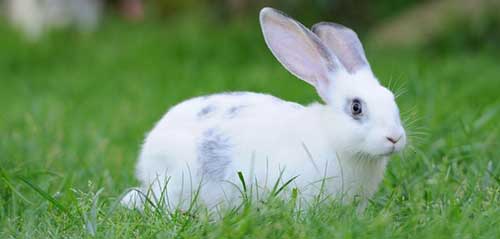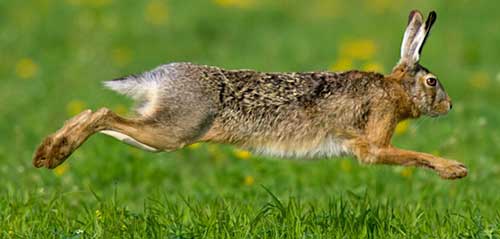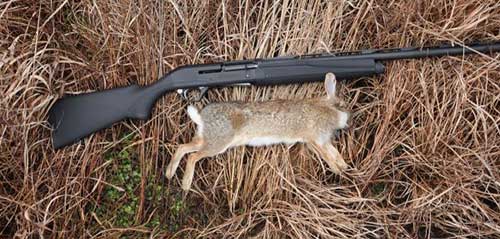Even the most experienced hunter may find themselves scratching their heads and wondering what exactly went wrong the first time they try to hunt for rabbits.
This small, fluffy animal presents a special sort of challenge that can make hunting for rabbits without dogs an especially fun and challenging experience. They will test your patience and leave you flabbergasted with their behavior at times.
Nevertheless, in the end, should your hunt be successful, you’ll be rewarded with a good meal and warm hide that you can tan and use to make a hunting bag, a pair of mittens, or to hang on your wall as a trophy for a formidable -though often dismissed and underappreciated- opponent.
Know Your Weapon

When it comes to hunting rabbits, you really can’t go wrong with your trusty shotgun.
The 12-gauge shotgun is a good versatile weapon that can be used for everything from rabbits to coyotes to deer -covering most of the bases for your homestead or wilderness survival needs. Using a 6 or 7 ½ shot will be heavy enough to kill the rabbit rather than just dusting it and leaving it wounded and requiring another shot.
This is why I personally don’t recommend using a 20 gauge or .410, which are very popular choices for hunting rabbit. They lack the kick a 12-gauge has and the range that can be crucial when trying to hit a rabbit out in the open or as it runs off in front of you. In my mind, whatever works to take down the rabbit in one shot -reducing the chances of just wounding it and causing it to suffer- and doesn’t impact the meat quality will always be your best choice.

Know Your Prey
In the US, there are thirteen different species of cottontail rabbits, with the Eastern Cottontail being the most prevalent. Many areas tend to only have one type of cottontail species, but some areas (such as certain parts of New England, Florida, and the Pacific Northwest) will have as many as two or three different species.
Cottontails generally have similar behavior and diet, but individual species will have differing tastes, preferences, and behaviors due to their unique geographical locations. For this reason, it’s important to know the area where you’ll be hunting and to know the animal you’ll be hunting – which is an advice you can apply to hunting any animal.
Cottontails are fairly fragile creatures that can live as long as twelve years but rarely make it more than a few years in the wild due to predators and the harsh realities of winter. For this reason, a rabbit may spend its entire life knowing only a lush summer paradise or a snow covered landscape, never getting to experience the full turn of the seasons. Because of this, rabbits have evolved to reproduce quickly and plentifully and have developed certain behaviors that help to protect them from predators. Knowing these behaviors will help to give you an edge.

As mentioned earlier, rabbits are deceptive creatures that seem like it would be so simple to take down, yet can leave you missing more shots or not even seeing any rabbits in a woods filled with them. They have the propensity to hang out in areas where they have cover and protection. That means that approaching the branches of fallen trees or the low hanging branches of trees may scare up a bunny or two. The tall grasses along the edges of a forest are also a good place to try and scare up a rabbit, as are areas with thick underbrush.

But rabbits have a tendency to freeze when they see a predator. For this reason, for every rabbit you see, there were likely a dozen more that you passed by but were never aware of. This is also why when a rabbit thinks he’s got himself hidden in some good cover, he won’t move until you nearly step on him. This is why having that range on your gun comes in handy as you will most likely be trying to hit a rabbit out in the open that hasn’t seen you yet or you’ll be trying to hit one that’s running away from you at speeds up to 45 miles per hour.

Should that rabbit take off and leave you kicking yourself for missing a shot, take heart. Similar to deer, rabbits have a tendency to circle back to where they first were before being chased off. They make roughly a 100-yard circle, swinging back around to where the chase began.
Know Yourself
More than anything, when it comes to hunting rabbits, it’s important to understand that their behavior and movement creates an illusion in your mind.
When a rabbit takes off, it throws up a dust cloud. This causes your mind to think that your shot fell just behind the rabbit. Naturally, you try to compensate with an additional lead. However, as fast as they can run, rabbits will be gradually slowing down (they’re sprint runners, not cross country stars) so that means your next shots will be too far in front of the rabbit. This is why most people miss rabbits in front instead of behind. Being aware of this overcompensation allows you to pull back, increasing your chances of actually hitting your target.

Curious

Alert

Relaxed

Nervous/Aggressive

Relaxed/Sleepy
Given the rabbit’s behavior, your rabbit stalking tactics need to be especially fluid. Focus on moving slowly and in a manner that makes it appear that you’re not actually moving. Jerky movements will quickly scare off a rabbit, while ghosting through the forest will let you see that rabbit first, letting you get a shot in at a distance or to better position yourself to take that shot should it suddenly bolt.

Should you miss a shot, remember that rabbits have a tendency to loop back around to the area where they first were when spooked. That means if you hold, maybe even dropping down to one knee so you can better scan the ground, that rabbit will eventually come back into range giving you a chance to redeem yourself and still bring in supper.
How to Hunt Rabbits Like a Pro
Despite many hunters are not willing to bring themselves “down” to hunt small game, rabbit hunting can present a great challenge and help you to better pass the time in between large game seasons.
Plus, when cooked right, rabbit makes a tender and delicious meal that can be fried, roasted, or even baked into a pot pie. It’s a savory meat that is naturally lean and can bring some diversity to your diet.
Keeping the tips on this post in mind will help you to make the most of your next rabbit hunt.